Decision Spread
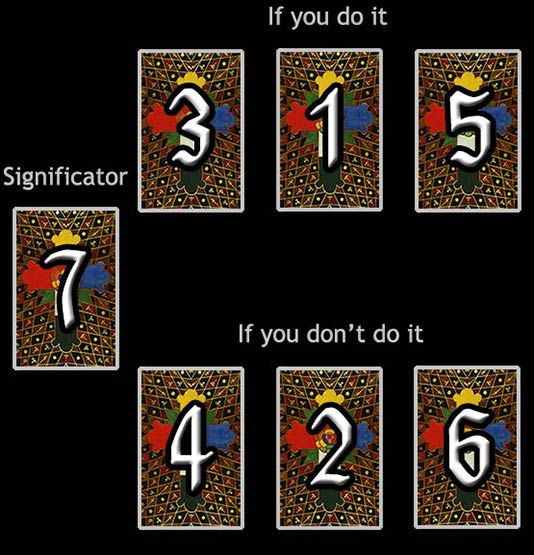
Difficulty: Easy
This simple but highly useful spread calls for a question to be asked in this format:
'What happens if I do (X), and what happens if I do not do (X)?'
Please note that it should not be viewed as a decision between two different options, but about whether a single option should be exercised or not. A second option would call for a separate reading.
Card #7 is the significator, the overall theme of the query.
Cards #3, #1, & #5 represent the chronological sequence of events that occurs if the reader chooses to do (X).
Cards #4, #2, & #6 represent the chronological sequence of events that unfolds if the reader chooses not to do (X).
Your Decision Reading
The Significator XVIII – The Moon |
Outcome if you do it: | ||
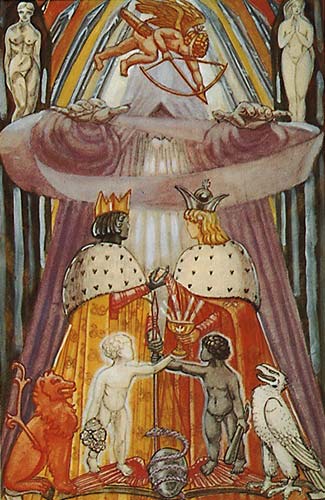 VI – The Lovers |
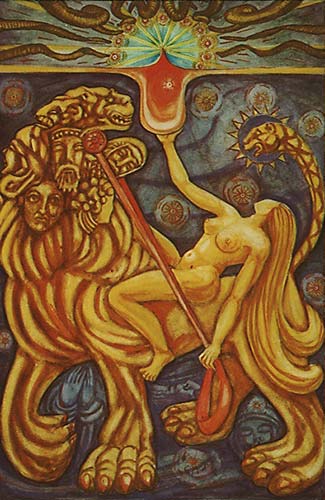 XI – Lust |
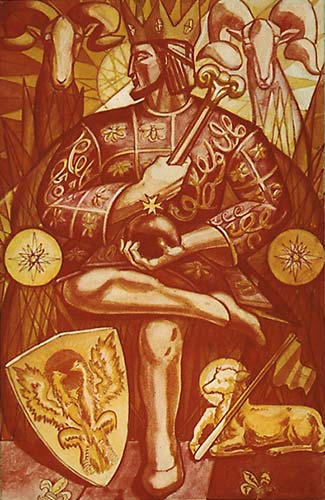 IV – The Emperor |
|
| Outcome if you don't do it: | |||
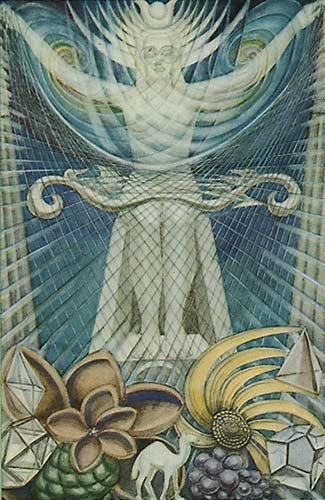 II – The Priestess |
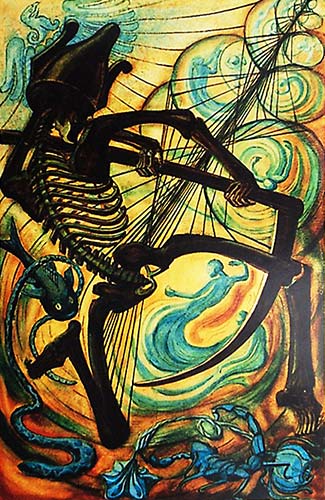 XIII – Death |
 IX – The Hermit |
|

XVIII – The Moon
(Pisces, Qoph)
The Moon symbolises illusion, intuition, and the mysterious depths of the subconscious. Associated with Qoph, the back of the head, this card delves into the primal and instinctual aspects of the psyche. Pisces, the zodiac of dreams and mysticism, enhances the card's themes of mystery and emotional depth.
The imagery is haunting and enigmatic. A path winds through barren terrain, flanked by twin towers that suggest gateways to the unknown. Above, the moon dominates the sky, casting an eerie light that obscures as much as it reveals. Crawling on the path is a scarab beetle carrying the solar disk, symbolising the emergence of light from darkness. The waters below teem with life, representing the fertile chaos of the subconscious.
In Relationships: The Moon represents emotional complexity and hidden dynamics. It encourages you to trust your intuition and uncover underlying truths.
In Work: This card suggests uncertainty or confusion. You are advised to navigate carefully, relying on intuition and patience to discern the best path forward.
Spiritually: The Moon symbolises the journey through the subconscious and the mysteries of the soul. It calls you to explore your inner depths and embrace the wisdom found in dreams and intuition.
When ill-dignified: The Moon warns of deception, confusion, or fear of the unknown. You are advised to confront your fears and seek clarity amidst uncertainty.
Outcome if you do it:

VI – The Lovers
(Gemini, Zain)
The Lovers represent the alchemical union of opposites, a card rich with symbolism of choice, harmony, and divine love. Associated with Zain, the sword, this card represents the piercing clarity needed to discern and unite polarities. Gemini, the zodiac of duality and communication, imbues it with the energy of connection and synthesis.
The Thoth Lovers card depicts the union of the royal figures of Sol and Luna under the guidance of a cupid-like angel. Below them, the Orphic egg is encircled by the serpent, symbolising potential and cosmic rebirth. The figures are surrounded by the emblems of alchemical transformation: fire and water, masculine and feminine, light and shadow. The imagery suggests not only romantic love but also the integration of the conscious and unconscious mind, as in shadow work.
In Relationships: The Lovers signify connection, mutual respect, and the merging of hearts and minds. It also emphasises the importance of choice and the conscious commitment to love and partnership.
In Work: This card suggests collaboration and harmonising diverse forces to achieve a greater goal. It encourages you to seek partnerships that align with your values and vision.
Spiritually: The Lovers represent the union of opposites within the self, a crucial step on the path to enlightenment. It calls you to embrace your inner dualities and find harmony through integration.
When ill-dignified: The Lovers caution against indecision, misaligned partnerships, or superficial connections. You are urged to examine whether you are avoiding responsibility or compromising your truth for the sake of harmony.

XI – Lust
(Leo, Teth)
Lust, known as Strength in many other decks, takes on a unique and profound meaning in the Book of Thoth. This card signifies the ecstatic embrace of life's passions and the power derived from uniting primal instincts with spiritual purpose. Associated with Teth, the serpent, it symbolises both the kundalini energy and the continuous cycles of transformation and renewal. Leo, the zodiac of courage and vitality, infuses the card with boundless confidence and creative expression.
The central figure is a woman riding a multi-headed beast, a symbol of primal forces mastered and directed towards a higher purpose. Her nudity represents authenticity and fearlessness, while the cup she holds aloft is the Holy Grail, symbolising the ultimate spiritual goal. The beast itself, covered in fiery hues, represents the dynamic power of creation, destruction, and renewal. The background is filled with swirling red and gold, reflecting the intensity of life force and divine energy.
In Relationships: Lust represents passion, desire, and a fearless embrace of emotional intensity. It encourages you to fully engage with your relationships, revelling in love's transformative power.
In Work: This card signifies success achieved through boldness, enthusiasm, and a connection to one's creative instincts. You are advised to channel your energy into projects that ignite your passion.
Spiritually: Lust symbolises the awakening of spiritual vitality and integrating one's primal and divine natures. It calls you to surrender to the ecstatic flow of universal energy.
When ill-dignified: Lust warns of unchecked desires, destructive passions, or an overindulgence in material pleasures. You are advised to restore balance and align your desires with a higher purpose.

IV – The Emperor
(Aries, Tzaddi)
The Emperor represents the force of order, authority, and structure, embodying the disciplined energy required to manifest power and stability in the material world. He is linked to Tzaddi, symbolising insight and vision, representing the ability to perceive higher truths and take decisive action in alignment with divine will. As the astrological ruler Aries, he brings fiery determination and a pioneering spirit.
The Emperor sits on a ram-adorned throne, a clear nod to Aries, surrounded by a vibrant red background that speaks of his dynamic energy and martial authority. His sceptre, along with the orb and cross, symbolises the dominion of spirit over matter. At his feet lies the double eagle shield, representing far-reaching vision and the ability to soar above obstacles. The geometric forms surrounding him suggest the stability of order, while the lamb beneath his throne reminds us of the balance between power and protection.
In Relationships: The Emperor indicates a relationship rooted in stability, leadership, and mutual respect. It calls for clarity, honesty, and the willingness to establish healthy boundaries and foundations.
In Work: This card represents mastery over the material realm and the ability to build structures that endure. It encourages you to take charge of your destiny confidently and lead by example.
Spiritually: The Emperor signifies the grounding of spiritual energy into practical action. He calls you to embody your highest ideals in your daily life, manifesting divine will through disciplined effort.
When ill-dignified: The Emperor warns of rigidity, authoritarianism, or a misuse of power. You are cautioned to balance control with flexibility and lead with wisdom rather than dominance.
Outcome if you do not do it:

II – The Priestess
(Moon, Gimel)
The Priestess is a figure of serene and inscrutable wisdom, embodying the mysteries of the subconscious and the cycles of the Moon. She corresponds to Gimel, the camel, representing the capacity to traverse vast spiritual deserts and access hidden truths. The Moon's influence lends her an air of receptivity, intuition, and connection to the rhythms of the cosmos.
Seated on her throne, the Priestess holds a bow, an emblem of Artemis and lunar cycles, symbolising her mastery of timing and precision. Her arms mirror the crescent moons of the background, merging her form with the sea of the unconscious. Before her, a tapestry adorned with pomegranates and palms veils the sacred mysteries, separating the seen from the unseen. At her feet lies the crescent moon, a symbol of her dominion over intuition and the waxing and waning cycles of existence.
In Relationships: The Priestess indicates the presence of profound emotional depth and unspoken bonds. It encourages you to trust your intuition and explore the layers of your connection without rushing to conclusions.
In Work: This card suggests the answers lie in reflection and inner knowledge rather than external action. It advises you to trust your instincts and remain patient while the path unfolds.
Spiritually: The Priestess represents the deep well of inner wisdom, the gateway to divine knowledge. She calls you to explore your dreams, meditations, and intuitions for insight into the mysteries of the self and the universe.
When ill-dignified: The Priestess cautions against passivity, confusion, or ignoring intuitive warnings. You are advised to confront hidden fears and distinguish between genuine intuition and projections of the unconscious mind.

XIII – Death
(Scorpio, Nun)
Death represents transformation, endings, and the profound renewal that arises from letting go. Associated with Nun, the fish, this card symbolises the regenerative cycles of life and the eternal flow of existence. Scorpio, the zodiac of intensity and rebirth, infuses the card with themes of metamorphosis and profound emotional depth.
The figure of Death is a skeletal figure wielding a scythe, harvesting the forms of life to make way for growth. Surrounding him are figures dissolving and reforming, emphasising the continual cycle of destruction and creation. Fish swim in the background, symbolising the life force that persists through change. The overall imagery is dynamic and alive, with a swirling interplay of light and shadow reflecting the transformative energy of this card.
In Relationships: Death signifies the end of a relationship or the transformation of its dynamics. It encourages you to release what no longer serves you, allowing space for growth.
In Work: This card indicates a major transition or the end of a phase. You are advised to embrace change and view endings as opportunities for renewal.
Spiritually: Death symbolises the shedding of old identities and the rebirth of the soul. It calls you to embrace transformation and trust in the process of spiritual evolution.
When ill-dignified: Death warns of resistance to change, fear of endings, or an inability to move forward. You are advised to confront your fears and trust in the natural cycles of transformation.

IX – The Hermit
(Virgo, Yod)
The Hermit represents the seeker of inner truth and the wisdom gained through solitude and introspection. Associated with Yod, the hand, this card embodies the divine spark of creation and the active quest for enlightenment. Virgo, the zodiac of analysis and service, lends the Hermit its meticulous and introspective energy.
The Hermit is a lone figure cloaked in red, symbolising both the concealment and revelation of profound mysteries. He holds a glowing lantern containing a star, representing the union of opposites and the illumination of divine wisdom. A serpent coils around the cosmic egg, an emblem of transformation and esoteric knowledge. In the foreground, a radiant yellow glow symbolises enlightenment, while the crop around him suggests the fertile soil of the unconscious mind.
In Relationships: The Hermit suggests introspection or solitude. It encourages you to seek clarity and the understanding of your own needs before reengaging with others.
In Work: This card indicates the value of independent effort and the importance of inner guidance. You are encouraged to trust your own wisdom and focus on long-term goals rather than immediate results.
Spiritually: The Hermit represents the solitary journey of self-discovery and pursuit of higher knowledge. It calls you to turn inward and seek truth through meditation and reflection.
When ill-dignified: The Hermit warns of isolation, excessive withdrawal, or a reluctance to share one's insights. You are advised to balance your introspection with meaningful connection and ensure you are not avoiding life's responsibilities.